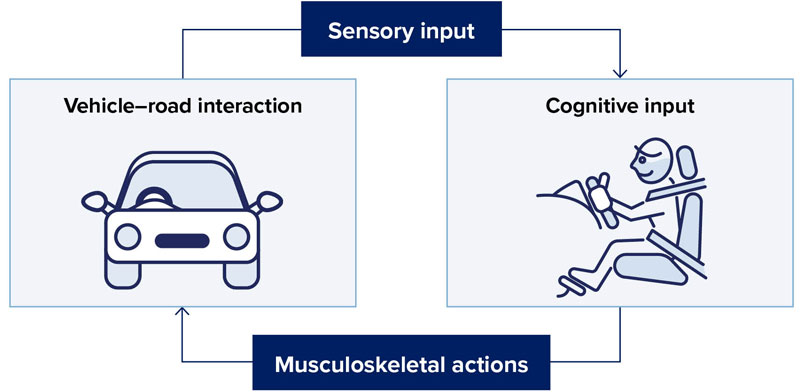2.1 The driving task
An understanding of the driving task, both generally and for the specific driver, underpins the assessment of fitness to drive and guides the determination of risk associated with impairment due to ill health.
Driving is a complex instrumental activity of daily living, characterised by a rapidly repeating cycle in which:
- Information about the vehicle and road environment is obtained via the visual and auditory senses.
- The information is operated on by several cognitive processes, which leads to decisions about driving.
- Decisions are put into effect via the musculoskeletal system, which acts on the various controls to alter the vehicle in relation to the road (refer to Figure 1).
This repeating sequence depends on:
- Sensory input
- vision
- visuospatial perception
- hearing
- proprioception
- kinesthesia
- Motor function
- muscle power
- coordination
- Cognitive function
- attention and concentration
- comprehension
- memory
- insight
- judgement
- decision making
- reaction time
- sensation.
Given these requirements, it follows that many body systems need to be functional to ensure safe and timely execution of the skills required for driving.
Furthermore, the demands of the specific driving task can vary considerably depending on a range of factors including those relating to the driver, the vehicle, the purpose of the driving task and the road environment (Box 1). For commercial drivers in particular these demands can be significant, as can be the consequences for public safety.
Assessing health professionals should document the individual’s driving requirements and driving history as part of the assessment process.
Figure 1: The driving task

Driving tasks occur within a dynamic system influenced by complex driver, vehicle, task, organisational and external road environment factors including:
- the driver’s experience, training and attitude
- the driver’s physical, mental and emotional health – for example, fatigue and the effect of substance misuse including illicit, prescription and non-prescription drugs
- the road system – for example, signs, other road users, traffic characteristics and road layout
- legal requirements – for example, speed limits and blood alcohol concentration
- the natural environment – for example, night, extremes of weather and glare
- vehicle and equipment characteristics – for example, the type of vehicle, braking performance and maintenance
- mental workload and distraction due to in-vehicle technologies (e.g. GPS, vehicle warning/alert systems, driver assistance systems) and communication systems (hands-free phone/email systems)
- personal requirements, trip purpose, destination, appointments, navigation tasks and time pressures
- passengers, in-vehicle communication/entertainment devices and their potential to distract the driver.
For commercial or heavy vehicle drivers there is a range of additional factors including:
- business requirements – for example, rosters (shifts), driver training and contractual demands
- work-related multitasking – for example, interacting with in-vehicle technologies such as a GPS, job display screens or other communication systems
- legal requirements – for example, work diaries and licensing procedures
- vehicle issues including size, stability and load distribution
- passenger requirements/issues – for example, duty of care, communication requirements and potential for occupational violence
- risks associated with carrying dangerous goods
- additional skills required to manage the vehicle – for example, turning and braking
- endurance/fatigue and vigilance demands associated with long periods spent on the road.
